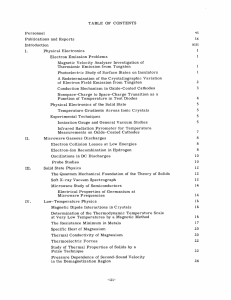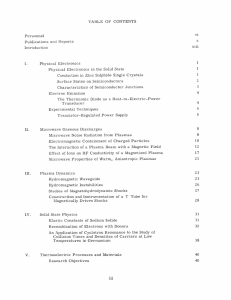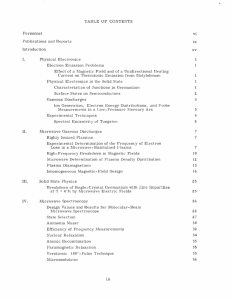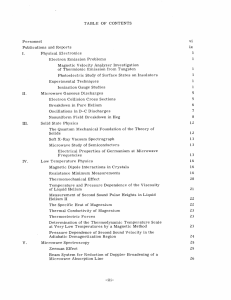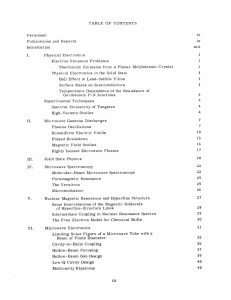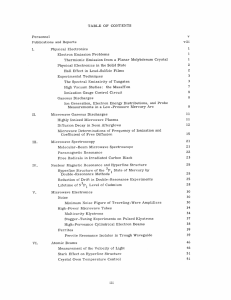IX. MICROWAVE ELECTRONICS Prof. L. D. Smullin
advertisement
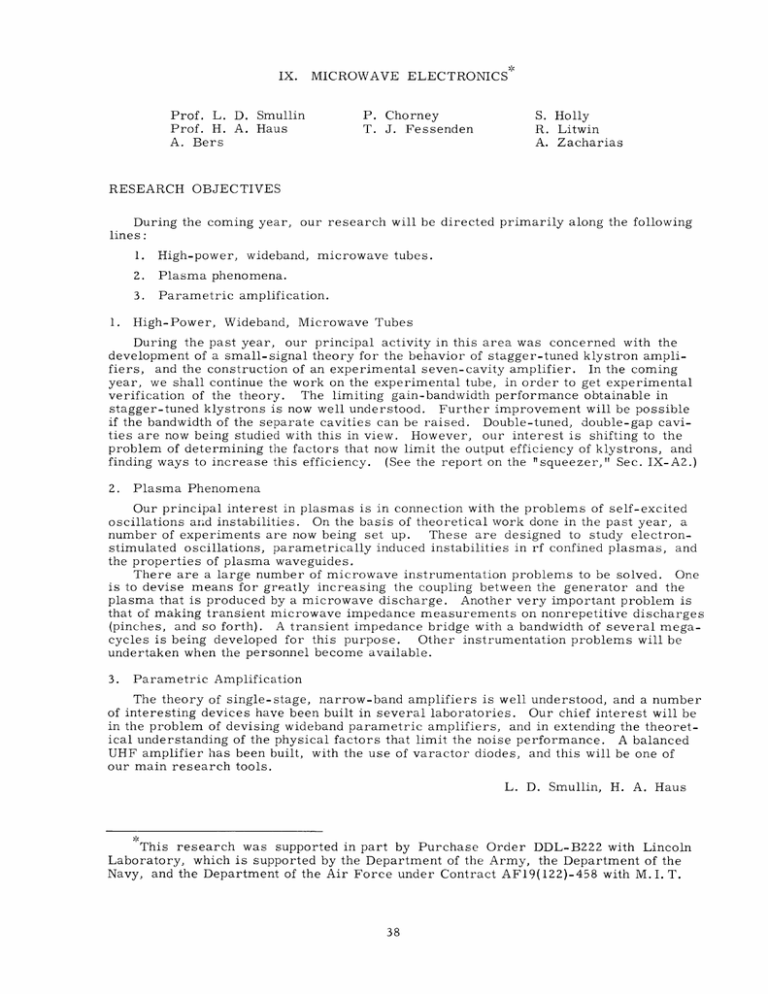
IX. MICROWAVE Prof. L. D. Smullin Prof. H. A. Haus A. Bers ELECTRONICS P. Chorney T. J. Fessenden S. Holly R. Litwin A. Zacharias RESEARCH OBJECTIVES During the coming year, our research will be directed primarily along the following lines: 1. 1. High-power, wideband, microwave tubes. 2. Plasma phenomena. 3. Parametric amplification. High-Power, Wideband, Microwave Tubes During the past year, our principal activity in this area was concerned with the development of a small-signal theory for the behavior of stagger-tuned klystron amplifiers, and the construction of an experimental seven-cavity amplifier. In the coming year, we shall continue the work on the experimental tube, in order to get experimental The limiting gain-bandwidth performance obtainable in verification of the theory. stagger-tuned klystrons is now well understood. Further improvement will be possible if the bandwidth of the separate cavities can be raised. Double-tuned, double-gap cavities are now being studied with this in view. However, our interest is shifting to the problem of determining the factors that now limit the output efficiency of klystrons, and finding ways to increase this efficiency. (See the report on the "squeezer," Sec. IX-A2.) 2. Plasma Phenomena Our principal interest in plasmas is in connection with the problems of self-excited oscillations and instabilities. On the basis of theoretical work done in the past year, a number of experiments are now being set up. These are designed to study electronstimulated oscillations, parametrically induced instabilities in rf confined plasmas, and the properties of plasma waveguides. There are a large number of microwave instrumentation problems to be solved. One is to devise means for greatly increasing the coupling between the generator and the plasma that is produced by a microwave discharge. Another very important problem is that of making transient microwave impedance measurements on nonrepetitive discharges (pinches, and so forth). A transient impedance bridge with a bandwidth of several megacycles is being developed for this purpose. Other instrumentation problems will be undertaken when the personnel become available. 3. Parametric Amplification The theory of single-stage, narrow-band amplifiers is well understood, and a number of interesting devices have been built in several laboratories. Our chief interest will be in the problem of devising wideband parametric amplifiers, and in extending the theoretical understanding of the physical factors that limit the noise performance. A balanced UHF amplifier has been built, with the use of varactor diodes, and this will be one of our main research tools. L. D. Smullin, H. A. Haus This research was supported in part by Purchase Order DDL-B222 with Lincoln Laboratory, which is supported by the Department of the Army, the Department of the Navy, and the Department of the Air Force under Contract AF19(122)-458 with M. I.T. (IX. A. KLYSTRONS 1. Linear Space-Charge Theory of Gap Interaction In the Quarterly Progress Reports of July 15, MICROWAVE ELECTRONICS) 1958 and October 15, 1958 (1, 2) we presented a formulation of the small-signal, one-dimensional, gap interaction neglecting space-charge fields. In the present report we shall present a complete space-charge theory. ELECTROMAGNETIC CIRCUIT (RESONATOR) ELECTRON STREAM S b !Fig. - r, Ss -d IX-1. Electron stream in a region of nonpropagating gap fields. 6 d Consider the electron-electromagnetic system of Fig. IX-1, which is cylindrical with respect to the z-direction and symmetric about the z = 0 plane. The electromagnetic Hc(r,z)] are assumed to be nonpropagating, fields of the circuit [_Ec(r, z), vanishingly small at the reference planes z = ±~. and to be The electron stream is assumed to be confined by an infinite magnetic field so that the interaction is entirely longitudinal; the interaction is only with the z-component of the electric field of the circuit. that is, We define a complex gap voltage (1) E (a, z) dz = - V -c gd and a gap current Ig, so that the electromagnetic power flow from the circuit through the surface S is given by 2 1 c X -C * .dS=V 2 (2) I g g We shall describe the signals that propagate along the electron stream, ticular radial position, in terms of the beam current at a par- I(z) and the kinetic voltage V(z) = (m/e) vo v(z), where v 0 is the time-average electron velocity, and v(z) is the complex amplitude of the time-variant electron velocity. We shall assume throughout This work was supported in part by the U. S. Navy (Office of Naval Research) under Reproduction in whole or in part is permitted for any purpose Contract Nonr-1841(49). of the United States Government. (IX. MICROWAVE ELECTRONICS) this report that the electron stream is thin so that the electric field over its cross section is constant, and the beam current I(z) = o-J(z), where 0- is the beam cross section, and J(z) is the complex amplitude of the time-variant electron-current density. Under the assumptions of small-signal theory the entire system is linear. Hence, by superposition, we have V2 Y11 Z1 2 13 12 Y21 Y2 2 Y23 I1 Ig Y3 Y3 2 Y33 Vg 1 where V 2 = V(+f), 12 = I(+f), 1 (3) V 1 = V(-f), and I 1 = I(-i). The elements of the matrix are expressible in terms of the characteristic waves of the electron-stream the Fourier integrals of the circuit field for these waves. system and Let the phase constants of the beam waves be (fast beam wave) - Pq P+ = (4) (slow beam wave) q P_ = Pe + pe = w/v o , with o the operating frequency; and Pg = W /Vo, with co the o g gog reduced plasma frequency. We then define the Fourier integrals of the circuit electric where field for these waves: where (5) d(P±z) e (z) 0 M= (p z) is the normalized electric field of the circuit and E-c &( z) (6) Vg z) = which is a real and even function of p z. Making use of the superposition principle, the symmetry properties of the system, the small-signal, kinetic power theorem, and the conservation-of-energy equation, we obtain 1 (-jP+ yll = 22 Z1 Y21 21 =i Z 1 Z (eJ+ -jp- 21 2 e + e e-j o space-charge drift equations, (7) - epz 2 - e -jp (8) 2 (9) (9) the (IX. -j p- 1 = Y 13 Y2 3 (M = Y3 31 + M e 2o (10) e - M- e + 33 f± (11) ) 00 1 2 Y o (f + - f_); 2 33 MICROWAVE ELECTRONICS) -jO ± (O ) e0 dO d (12) 5(a) e" -00 -00 where Y I 1 oZ 1 o 2V o o is the characteristic admittance of the beam, and V 33 g I =V 1 =0 is the electronic admittance of the stream which loads the circuit. Its real part is obtained from the kinetic power theorem For convenience, and Y33 = Ye = Ig g a. 23) = 41 Yo (M 13 Ad let yll 12 - M2 ) 12Bd' Y 1 2 B 12 (13) C 13ac d' Y13= Y32 c' Y23 23 Y31 31 bc' c' Equation 3 becomes V 2] I = Re( Ge Re Y 3 3 Ad Bd ac Cd Ad b b a Ye c c V1 (14) I el V g Beam Transformations for a Passive Circuit If the circuit is passive, Y c + Y Y ef = I g = -Y cg V (Fig. IX-2a). Let (15) Z The transformations of the beam current and kinetic voltage (Fig. IX-2b) can be written VZ) I A= ( C B )ie-j D eZ( V (II (16) (IX. MICROWAVE ELECTRONICS) + S A B e2 D)ee + kC V (b) V [F] V2 "l FEEDFORWARD I, CASCADE v V 12 - --- H H- [Del Yo, [G] + ~12 +V2 Yo ,+ [c]) (d) (C) Fig. IX-2. C [D] (a) Gap with passive circuit. (b) Equivalent linear two-port. (c) Feedforward and cascade representation. (d) Drift-gap-drift representation. Two convenient formulations of the matrix in Eq. 16 will now be given. From Eq. 14, we have directly A B)e -jpe, 2 Ad ac Bd) + (b C D Cd (-be -acl Z (17) c Ad feedforward cascade which consists of two matrices with distinct meanings (Fig. IX-2c). matrix which is a transformation that occurs when V = 0. the interaction with the circuit. Furthermore, The second matrix contains Equation 16 is a generalization of the concepts of feed- forward gain and cascade gain and their superposition (3). The first is a drift which we have stated previously it is possible to generalize the inspection technique (3) for writing the transformation of kinetic voltage and beam current for a cascade of structures of the kind shown in Fig. IX- 1. Another convenient representation is obtained by premultiplying and postmultiplying Eq. 16 by the drift matrix of length f and its inverse. The result is a representation in terms of a product of matrices which may be identified with drift and gap parameters (Fig. IX-2d). B A C where : [Di] [G] [D] (18) (IX. [ [D] jZ jY0 Sin f cos p oq ELECTRONICS) sin p Fcos p~I q ° MICROWAVE (19) = 1 - G [G]= Z -M Z 2 S (20) Z 1- Ge Z M where M = 1/2 (M + M_), and Gef is as given by Eq. 13. The nonreciprocal nature of the system is described by -jpe41 (AD - BC) e = (1 - 2G Z) e -jpe41 e (21) in which the first factor is associated with the gap matrix (Eq. 20), and the second factor expresses the unidirectional drift of the electron stream. A. Bers References 1. A. Bers, Klystron gap theory: Small-signal analysis, Quarterly Progress Report, Research Laboratory of Electronics, M. I. T., July 15, 1958, p. 49. 2. A. Bers, Klystron gap theory, Quarterly Progress Report No. 51, op. cit., 1958, p. 64. 3. A. Bers, Multiple-cavity klystron theory, Quarterly Progress Report, op. cit., April 15, 1956, p. 25. 2. The Squeezer (High-Efficiency Bunching) a. Introduction One of the limitations on klystron efficiency is the output gap. Oct. 15, With finite gap transit angle, a spread in velocity of the arriving electron beam effects a serious reduction in efficiency from the ideal limiting values calculated on the basis of the amplitude of the fundamental current. The one-dimensional space-charge theory predicts that the maximum fundamental current that can be achieved without overtaking is Ii = 0. 8810 if the modulation voltage across the infinitesimal input gap is V 1 /2V 0 =w /w. In order to achieve a larger cur- rent, it is necessary to modulate the beam by a larger voltage so that space-charge forces are overcome and overtaking occurs. We propose to achieve a higher current modulation without completely overcoming space-charge forces by using a series of closely spaced, low-impedance, cascade bunchers. The beam will be bunched by an (IX. MICROWAVE ELECTRONICS) input cavity to produce a current maximum and velocity minimum at the input to the squeezer, Fig. IX-3. The squeezer consists of several closely spaced, detuned, uncoupled cavities. inductively The output cavity, which is immediately adjacent to the squeezer, BUNCHED ELECTRON STREAM is SQUEEZER of conventional design. The squeezer is like an Easytron except that it has no input or output circuit connections INPUT z=0 OUTPUT and is CAVITY S= CAVITY maximum theoretical output current, Fig. IX-3. to operated as a low-gain device. (The Ii, is 210, and the input current, I ,l is approximately 0. 61 - a maximum gain of 10 db.) The impedo ance level of each cavity (adjusted by detuning) Arrangement of microwave structure for the squeezer experiment. is set to produce an electric field at the beam slightly larger than the space-charge field that is tending to debunch the beam. In this way, the beam is gradually formed into a tighter bunch without allowing overtaking to occur. An experimental study of the bunching process is being started. A perveance 10 - 6 shielded gun, producing a 0. 2-inch diameter beam at 10-20 kv will be used in a demountThe output cavity has been loaded to QL able system with movable cavities. a gap impedance of 3000 ohms. = 18, with This is low enough as compared with the beam imped- ance to insure small-signal behavior in the output gap. b. Theoretical Analysis of the Squeezer: Quasi-Large-Signal, Space-Charge Theory In a one-dimensional system of an electron stream interacting with circuit fields, the velocity of the electrons is given by the following differential equation: 2 +ciE.2 d v(z, t) S + dt t(zFt) 2 v pv(z, t) = o v c (zt)] (1) + o where wo is the electron plasma radian frequency, p J o is the time-average electron The time-average electron charge current density, and Ec(z, t) is the circuit field. density is assumed to be neutralized by fixed ions. Equation I is a generalization of the bunching equation in a drift region (1, 2). Consider a bunched electron stream entering a lossless Easytron structure. The circuit consists of a series of closely spaced resonators that are uncoupled to each other in the absence of the beam. (See Fig. IX-3.) If we assume that the circuit field induced by the bunched beam is only dependent upon the bunch distribution at the entrance, z = 0, t =to , [Ec = Ec(to)] then the right-hand side of Eq. and the differential equation is easily solved. I is distance-independent If at the entrance plane the current (IX. MICROWAVE ELECTRONICS) modulation is J(o,t o ) = J + aJ cos wt (2) and the velocity modulation is zero, a Fourier analysis of the current in the squeezer, with the assumptions of small-velocity modulations and no overtaking, gives for the maximum fundamental component of the current 2J = J 1(X) (1+ (3) in which X is a space-charge bunching parameter given by X2 J - o e p - Sn Op + p / J o E(t) o (1 (4) e p where Jc (to) is the circuit current, and E(to) is the total electric field at the entrance to the squeezer structure. If the entering stream is considered as bunched to just overtaking, a = 0. 88, then Eq. 3 has a maximum value of 0. 89 (or 89 per cent electronic efficiency) for X = 1. 5. However, the value of X is limited by the assumption of no overtaking. Under such conditions Eq. 4 shows that X is approximately unity, and the corresponding value for IJ 1 /J ° from Eq. 3 is 0. 83 (or 83 per cent electronic efficiency). A. Bers, T. J. Fessenden, S. Holly, L. D. Smullin References 1. H. A. Haus, Propagation of noise and signals along electron beams at microwave frequencies, Sc. D. Thesis, Department of Electrical Engineering, M. I. T., 1954. 2. A. J. Lichtenberg, Large signal space-charge analysis of klystron, Internal Memorandum, Microwave Laboratory, Research Laboratory of Electronics, M. I. T., 1956. B. PLASMA STUDIES 1. Traveling-Wave Two mercury, Experiments hot-cathode, and 30 inches long, discharge tubes, 0.5 inch in diameter, 20 inches are being used to investigate the propagation of slow plasma waves in a coaxial structure, in the presence of an axial magnetic field. Slow waves similar to those predicted theoretically (1,2) and observed by Trivelpiece (2) have been observed. P. Chorney, L. D. Smullin (IX. MICROWAVE ELECTRONICS) References Research 1. P. Chorney, Electron-stimulated ion oscillations, Technical Report 277, Laboratory of Electronics, M. I. T., May 26, 1958. 2. A. W. Trivelpiece, Slow wave propagation in plasma waveguides, Technical Report No. 7, Electron Tube and Microwave Laboratory, California Institute of Technology, May 1958. 2. Parametric Instabilities in Plasmas Recently, several schemes have been proposed (1, 2) by which a plasma might be -2 contained in a strong rf field with a proper spatial distribution of grad E , where E is the amplitude of the rf fields. In this connection, it has been shown that the nonlinear response of a plasma in an rf field leads to time-average forces that might be used for confinement. An rf field capable of confinement naturally produces a strong oscillatory motion in This oscillatory motion, together with the nonlinear characteristic of the the plasma. plasma, may lead to a time variation in the plasma parameters, and hence cause a "parametric" effect analogous to that occurring in ferrites, and actually employed in the It seems likely that rf confinement schemes might be ferrite parametric amplifier. plagued by the presence of parametric instabilities. It is also conceivable that para- metric effects might be employed for obtaining plasma heating, or for achieving power gain similar to that achieved in other parametric amplifiers that utilize nonlinear media. A study of nonlinear parametric effects in plasmas has been started. more important formulas and results obtained, Some of the together with the assumptions used, We consider a stationary, zero-temperature plasma of will now be summarized. electrons and heavy ions immersed in a (in general) nonuniform dc magnetic field B oFor the purpose of analysis of the parametric action, the ions are considered immobile. Denote the ion density po(r), and the displacement of an electron from that ion, with which the position of the electron would coincide in the absence of an rf excitation, Then, the current density J(r, t) at the position r, d(r, t). to second order in d, is given by . ad J(r, t) = p0 a a8t (- o - ad a(1) at The force equation to second order in the rf excitation is a d at2 e E+ d Xd XB at m o + + E +dd-a V+ X (d t V) Bo + t XB (2) In these equations all quantities are rf time-dependent quantities except for the dc magnetic field Bo 0. Equations 1 and 2, in conjunction with Maxwell's equations, (IX. aH - VX E -o - VX H J + Eo V .EE =p V MICROWAVE ELECTRONICS) at 8E t oH = 0 specify the system completely. Using the above equations, we have proved the Manley-Rowe relations for a plasma system supporting modes at the frequencies wl', ± w1 . These modes are assumed to be excited to a small level, wheras the pump excitation at the frequency wo is assumed to be large. plasma. Denote by S a surface completely enclosing the parametrically excited Then, the Manley-Rowe relations are E 0 xH 1 E o° + -1 X H o -1 E +1 1 xH+ +1 o The method where E n and H n are the small-signal fields at the frequency noo + wl of lossless-mode-coupling can then be applied to the analysis of such systems, as has been indicated in another paper in connection with parametrically excited longitudinal electron beams (3). H. A. Haus References 1. H. A. H. Boot, S. A. Self, and R. B. R. Shersby-Harvie, Containment of a fully ionized plasma by radio frequency fields, J. Electronics and Control, pp. 434-453 (May 1958). 2. E. S. Weibel, Confinement of a plasma column by radiation pressure and its application to fusion power generation, Report ARL-57-1026, Ramo-Wooldridge Corporation, Los Angeles, California, 1957. 3. H. A. Haus, Trans. IRE, 3. Approximate Field Solutions Kinetic power theorem in parametric longitudinal beam amplifiers, PGED (to be published). The fields in waveguides that contain stationary plasmas, drifting beams, or both, are normally found by a small-signal analysis of Maxwell's equations, the force equation, and the current-velocity relation. A result of this analysis is a determinantal equation which, when it is solved in conjunction with boundary-condition expressions, yields propagation constants P as a function of w for discrete orthogonal modes. If in the determinantal equation we make the simplifying assumption that (IX. MICROWAVE ELECTRONICS) >>k2 (1) 2 w E to, we generally obtain consistent results that validate our simplifying assumption. The expression for the electric-field components, when subjected to this assumption, becomes so simplified that we observe immediately that the approximate electric field can be expressed as the gradient of a scalar potential function c; that is, 2 2 where k E = - V (2) which means that Vx E = 0 (3) That the electric field is approximately given by Eq. 2 is an observation made from particular problems that have already been solved. However, it can be demonstrated, in general, that the simplifying assumption, Eq. 1, leads to Eq. 2. Maxwell's equations can be separated into two wave equations: 2 7 2 Eoo 2 2 VAA A oEo E (4) ~J (5) o a8t 2 -- at where A and 4 are the vector and scalar potentials (1). If we assume sinusoidal time dependence and propagation in the z-direction so that all fields are proportional to ejt e - j pz , then Eq. + (k 2 V2 4 becomes 2 T P (6) E0 in which we have used V Now, VT + i z a neglecting 2 k2 in comparison with V2 =- 2 P2, we obtain, as in electrostatics, (7) which leads to Eqs. 2 and 3. The simplified determinantal equation and approximate field solutions can now be obtained directly from the original basic equations, but with the Maxwell equation VX E = -j oH replaced by Eq. 2. This quasi-static, or electrostatic, approximation effectively regards the ac (IX. magnetic field as second-order. The use of Eq. MICROWAVE 1 in Eq. ELECTRONICS) 5 obviously suggests a mag- in which the electric field is regarded as second-order. This is the approximation used in magnetohydrodynamics, in which displacement curnetostatic approximation, rents are ignored (2). P. Chorney References Theory (McGraw-Hill Book Company, Inc., 1. J. A. Stratton, Electromagnetic New York, 1941), pp. 23-25. 2. T. G. Cowling, Magnetohydrodynamics 1957), pp. 2-3. C. MEASUREMENTS OF THE PHASE CONSTANT OF THE SLOW WAVE OF A (Interscience Publishers Inc., New York, HELIX WITH THE USE OF THE RESONANCE METHOD Measurements of the phase constant and of the phase velocity of the slow wave of a helix have been made. The helix was considered as a section of a one-dimensional transmission line opened at both ends. cies f, The resonances of such a line occur at frequen- at which the length fl of this line is the wavelength along the z-axis. (nl/2)Xz , with n 1 any integer, and X z The phase constant calculated from these quantities is given by 2 z 1 1 and the corresponding phase velocity is 0 2ffl p P n H is a typical Figure IX-4 is a schematic diagram of the experimental arrangement. The helix, supported by a thin sheet of polyS-band helix, scaled up by a factor of 3. foam, is assumed to be in free space. The exciting loop L 1 , and the pick-up loops L 2 and L 3 , are very weakly coupled to the helix. Loops L 1 and L 2 are fixed in position, can be moved parallel to the axis of the helix. The matching attenuator A and loop L 3 and the crystal-diode detectors D are placed very close to the loops to avoid possible resonances in loop circuits. The value of n 1 is obtained by observing changes of resonance indications caused by perturbations of the field by a metal sphere (not shown on the drawing) that is moved parallel to the axis of the helix. The same measurement can be made by moving the loop L 3 along the helix. (IX. MICROWAVE ELECTRONICS) WAVE WAVE- DC METER I E METER z Fig. IX-4. OSCILLOSCOPE Experimental arrangement. 9 8D 3 I -- 2 d p = 118 03 CM CM 0725 CM , SId- G 01 O 0.H 500 O3 1000 L 1500 4 O5 2000 f(MC) Fig. IX-5. Phase constant, constant, k, p, of the slow wave normalized to the free-space phase versus frequency or ka. Errors that arise from the fringing field at the ends of the helix can be eliminated by computing the phase constant from measurements taken along a section of the helix, which excludes the ends. If the wavelength along the z-axis equals twice the pitch-length p, the field measured by loop L 3 is the same opposite each turn of wire. The phase constant in this case equals P3= r/p. For somewhat different wavelengths, the field measured at each turn changes periodically along the helix. By measuring the length of one of these complete periods, f2 , the value of the phase constant can be calculated from the formula The plus sign for the origin is used if z is less than 2p, and the minus sign is used if X z is greater than 2p. (IX. MICROWAVE ELECTRONICS) Figure IX-5 shows curves of normalized phase constant versus frequency. The solid line is the curve predicted by the sheath helix theory (1, 2); the dotted line is the experimental curve. urements, The agreement between these curves is within the accuracy of the meas- that is, approximately 2 per cent. R. Litwin References 1. J. R. Pierce, Traveling-Wave Tubes (D. Van Nostrand Company, Inc., New York, 1950). 2. S. Sensiper, Electromagnetic wave propagation on helical conductors, Sc. D. Thesis, Department of Electrical Engineering, M. I. T., 1951.
